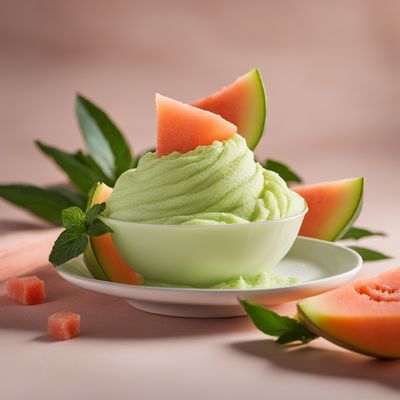
Ingredient
Melons
"The Juicy Delights: Exploring the World of Melons"
Melons are a type of fruit that belong to the Cucurbitaceae family, which also includes cucumbers and squash. They come in various shapes, sizes, and colors, with the most common types being watermelon, cantaloupe, and honeydew. Melons have a thick rind and a soft, juicy flesh that ranges from pale to vibrant hues. Their texture can vary from crisp to tender, depending on the variety. The flavor of melons is typically sweet and refreshing, with subtle variations in taste between different types. They are known for their high water content, making them a hydrating and thirst-quenching choice.
Origins and history
Melons have a rich history that dates back thousands of years. They are believed to have originated in Africa and were cultivated in ancient Egypt, where they were highly prized for their juicy flesh and ability to thrive in arid climates. Melons were later introduced to Europe by the Romans and spread to other parts of the world through trade routes. Today, melons are grown in various regions across the globe, including Asia, the Americas, and Europe.
Nutritional information
Melons are low in calories and fat, making them a healthy choice for those watching their weight. They are also a good source of vitamins A and C, as well as potassium and dietary fiber.
Allergens
Melons are generally not associated with common allergens, but individuals with oral allergy syndrome may experience cross-reactivity with certain types of melons, such as cantaloupe.
How to select
When selecting melons, look for ones that feel heavy for their size and have a firm, unblemished skin. The skin should have a slight give when pressed, indicating ripeness. Avoid melons with soft spots or moldy patches. For watermelons, a yellow or cream-colored spot on the bottom indicates ripeness.
Storage recommendations
Whole, uncut melons can be stored at room temperature for a few days to allow them to fully ripen. Once ripe, they should be refrigerated to maintain their freshness. Cut melons should be stored in an airtight container in the refrigerator and consumed within a few days.
How to produce
Melons can be grown by amateur gardeners in warm climates with well-drained soil and ample sunlight. They can be started from seeds or transplants, and regular watering and fertilization are essential for healthy growth. It is important to provide support for the vines as they grow and to protect the fruits from pests and diseases.
Preparation tips
To prepare melons, start by washing the outer skin thoroughly. For watermelons, cut them into slices or wedges and remove the seeds if desired. Cantaloupes and honeydews can be halved, seeds scooped out, and then sliced or cut into cubes. Melons can be enjoyed on their own, added to fruit salads, blended into refreshing smoothies, or used as a topping for desserts. They can also be grilled or roasted to enhance their natural sweetness.
Substitutions
If melons are not available, other fruits with a similar texture and sweetness, such as peaches or nectarines, can be used as substitutes.
Culinary uses
Melons are commonly used in fruit salads, smoothies, sorbets, and desserts like fruit tarts and ice creams. They can also be incorporated into savory dishes, such as salads, salsas, and grilled kebabs, to add a touch of sweetness and juiciness.
Availability
Melons are commonly available in regions with warm climates, including countries like the United States, Mexico, Spain, Italy, China, and Brazil.

